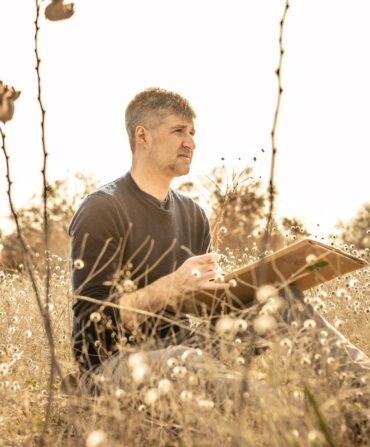Food & Drink
Black Walnut Fever
Armed with moxie and Nut Wizards, a dedicated throng of pickers hits suburbs, yards, and golf courses each fall during one of the South’s most unusual harvests
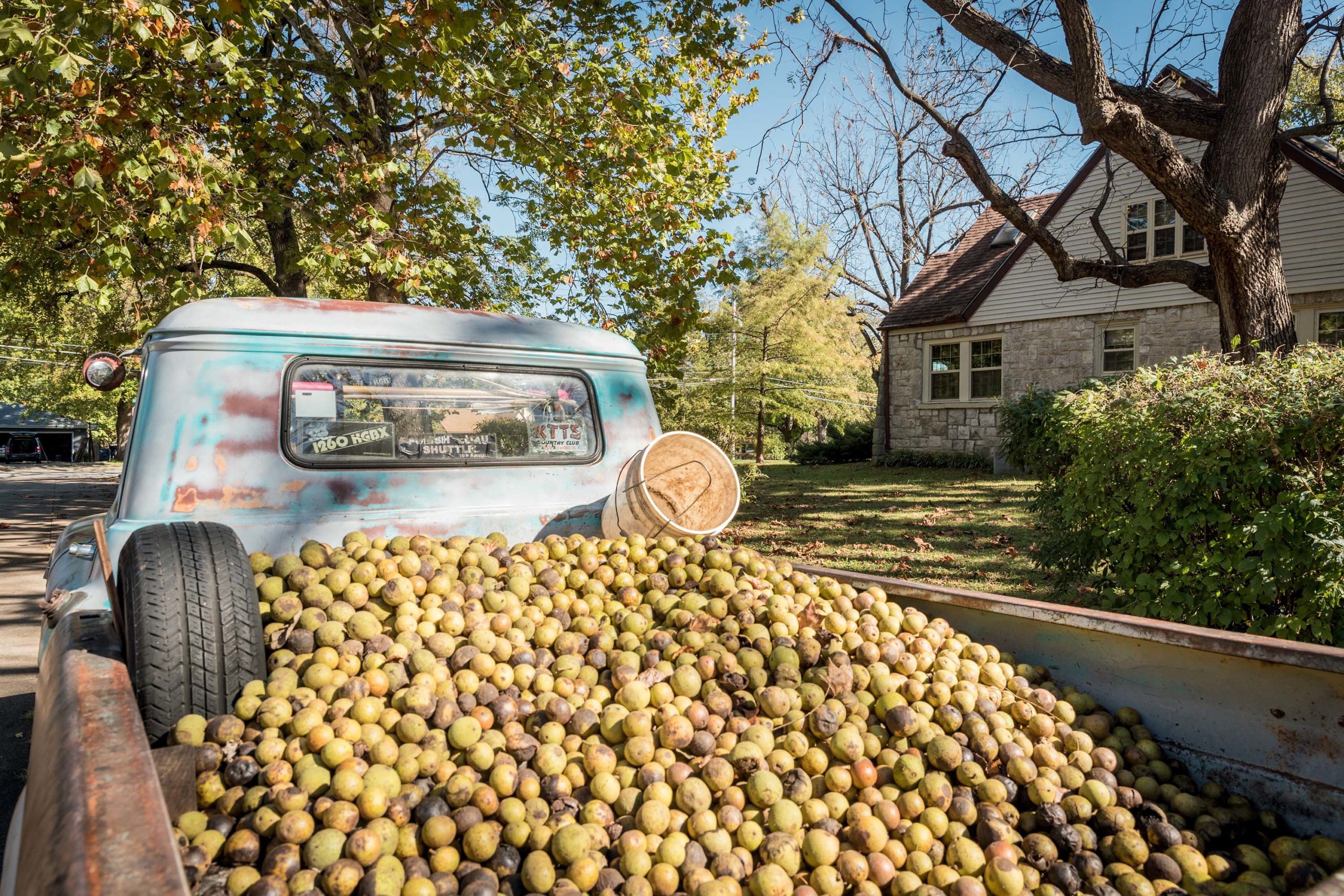
Photo: Eric Kiel
A picker’s truck piled high with black walnuts.
It’s the ice cream that does me in. I’m touring the sixty-five-acre Hammons Products Company plant in Stockton, Missouri. In business since 1946, Hammons is the only major processor of black walnuts left in the country. Outside, tractor-trailer loads of walnuts roll in from as far as seven hundred miles away and rumble toward the scales. Inside, white-coated technicians run twenty thousand square feet of computerized machinery to crack, shell, and sort nut meats into four sizes. Cracked nuts on conveyor belts pass through infrared beams that differentiate shell from meat. Tiny, precise puffs of air then separate the two. Before I leave, Brian Hammons, the grandson of the founder, tells me that around 40 percent of the company’s production ends up in ice cream and invites me to try some at the Hammons Emporium a few blocks away in the town’s tiny square.

Photo: Eric Kiel
Brian Hammons.
The young lady behind the counter offers me a choice. “Vanilla ice cream with walnuts or walnut ice cream with walnuts?” Walnut with walnut, I tell her. One taste and my eyes nearly roll back in my head. I’ve never had ice cream like this. It’s cappuccino-colored, rich, and deep. It’s adult ice cream. It tastes—incongruously, profoundly, deliciously—of earth.
Two very different kinds of walnuts grow in the United States. Almost all—about 98 percent—are the milder, thinner-shelled English walnuts. (They’re actually Persian walnuts, but that’s another story.) Almost all of them come from thousands of farms in California’s Central Valley. The remainder are the more robust black walnuts, one of the last wild-growing foods still commercially harvested in this country (the short list includes wild rice and wild mushrooms). Black walnuts are native to much of the Midwest and the South, especially Arkansas, Kentucky, and Tennessee. Native Americans had been harvesting them for thousands of years before Europeans showed up. They ate them, dyed their hair and clothing with them, used them in poultices and medicines. There are a few experimental black walnut orchards, but the nuts have never been farmed on any kind of scale. Each October, about a hundred thousand people in a thirteen-state black walnut belt collect some twenty-five million pounds of walnuts and haul them to 230 hulling operations run by Hammons, which in addition to supplying walnuts for ice cream sells the shelled nuts by the bag and in confections such as black walnut brittle.
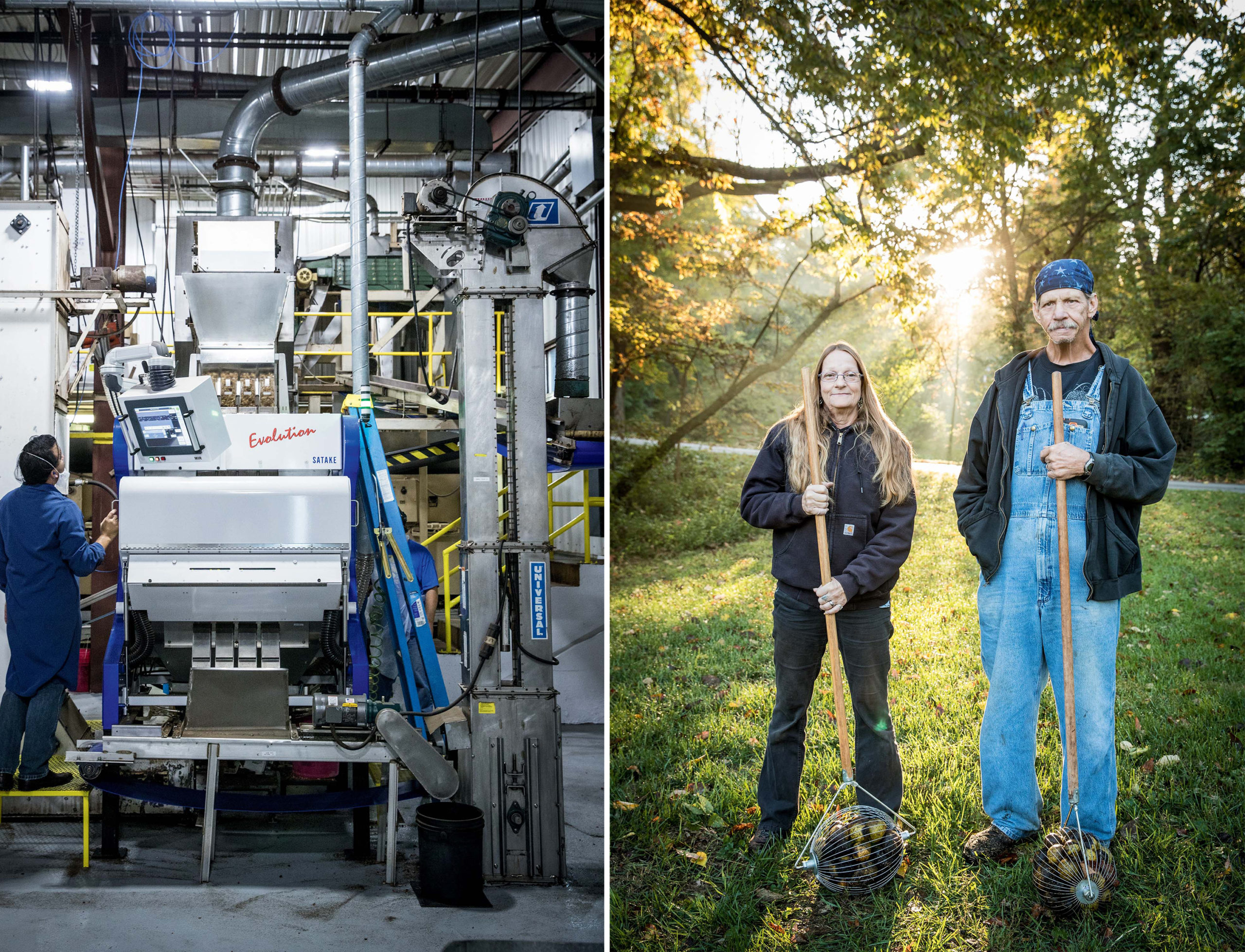
Photo: Eric Kiel
An electronic sorting machine separates shell from nut meat at the Hammons factory; Terry and Shaun Crocker.
Unless you know what to look for, you’ll drive right past these people. They don’t appear to be carrying on a uniquely American tradition. They look like
under-the-radar junk haulers. They wear gloves because stains from juglone—a compound in the hulls and tree roots that discourages the growth of other plants around black walnuts—last like tattoos. The pickers work in pairs, sometimes families. Look for somebody rolling a broomstick with a round wire basket at the end over the ground. These are Nut Wizards, invented just twenty years ago and a godsend. The basket’s wires are spaced so that walnuts can get in but not out. Roll your basket full, empty it into a bucket, repeat. The contraptions mean the difference between working standing up and working on hands and knees.
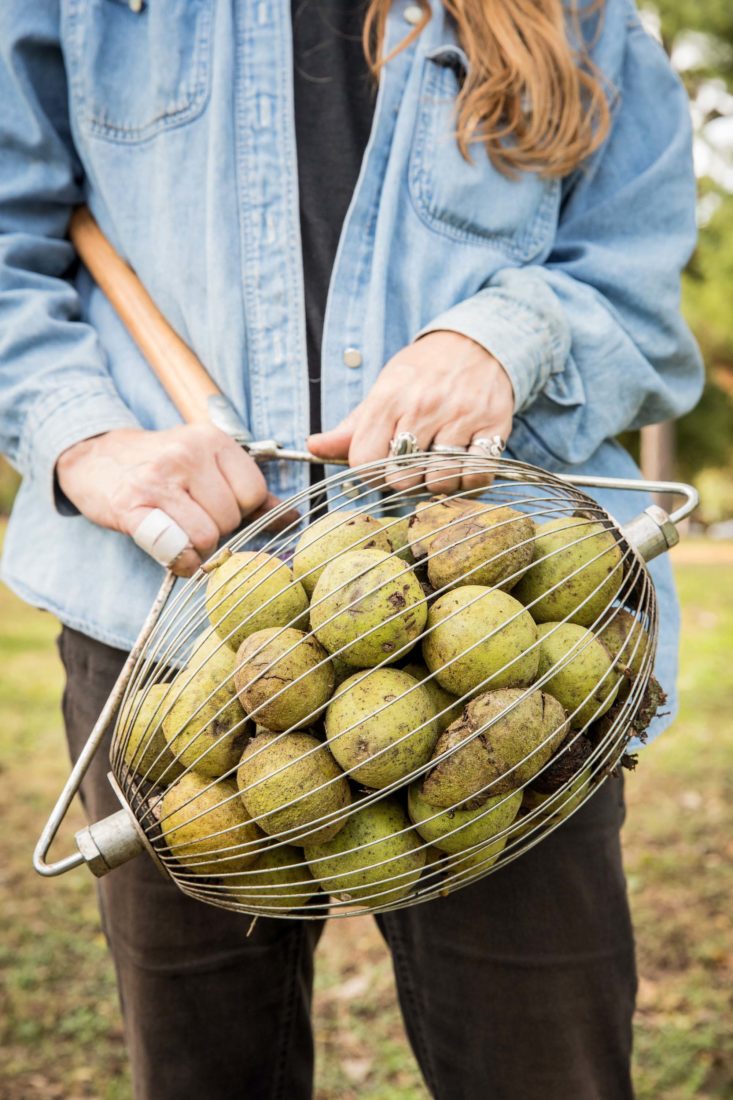
Photo: Eric Kiel
The Nut Wizard, an indispensable tool of the trade.
Don’t call them foragers. Foragers wander the woods with split oak baskets looking for truffles or some other delicacy. Pickers don’t have to search. They know where their trees are. Black walnut trees can grow more than a hundred feet tall, live for centuries, and don’t move around much. Pickers know which drop heaviest and first, which ones produce larger or smaller nuts. Most folks view the nuts as a nuisance. They’ll see working pickers and practically beg them to come get the damn things. The shell can chip a mower blade. The trees like sunlight, so they don’t favor deep woods. They grow in farm fields and suburban yards, in parks and on golf courses—almost anywhere, really. Two pickers spend a day collecting and driving between spots, then head to a hulling station such as the one at the Ozark Empire Fairgrounds in Springfield, Missouri, where two big yellow hulling machines roar six days a week for the month.
They’ll tell you they do it to buy nicer Christmas presents for their grandkids, maybe put away a little mattress money. Sometimes it’s a family carrying on a tradition. And it’s a way to show kids what real work is, how they can earn something they want with their own labor. All of this is wholly true. But I suspect it’s not quite the whole truth. Black walnuts are heavy. From thirty feet up, they land like little dud mortar rounds. They’ll dent a car just like hail. Many pickers wear hats more for protection than warmth, because picking is physical labor, work. In a state like Missouri, which is walnut central, there are thousands of people who look forward to October all year, gear up for it, who go out ten hours a day six days a week for the whole month. These are the ones I’m curious about.
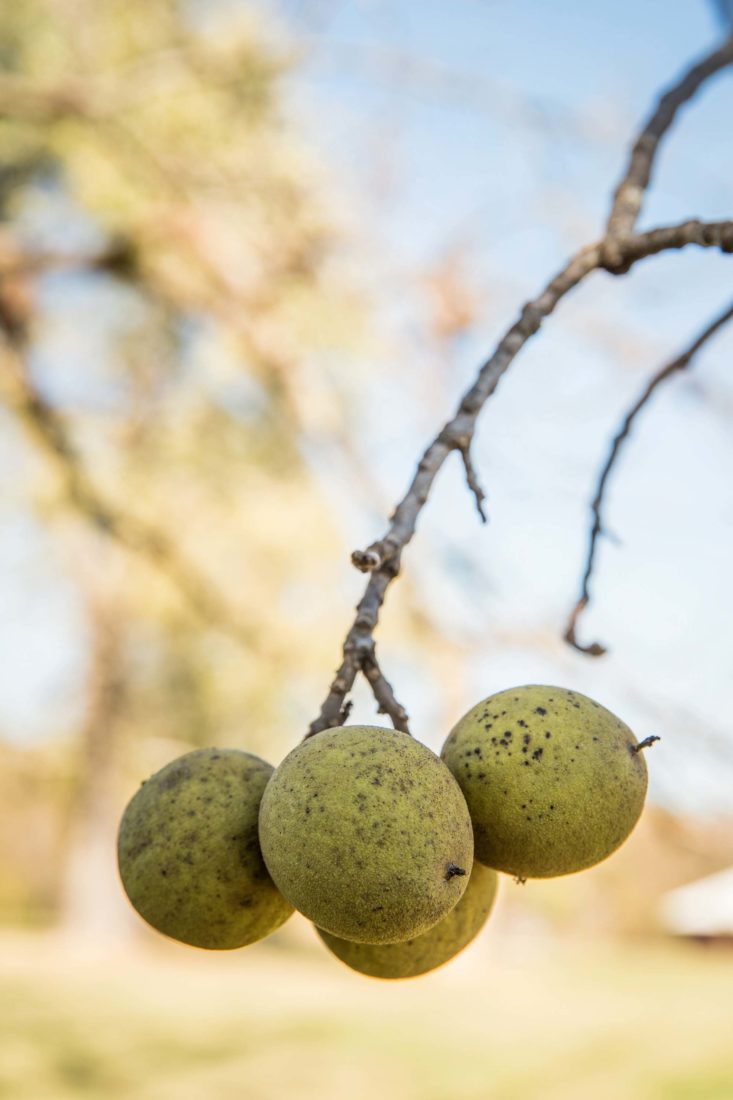
Photo: Eric Kiel
Black walnuts on the tree.
Numbers alone don’t seem to explain it. In a good year, two serious pickers working all of October could earn north of $3,000, before expenses, for their efforts. That’s nothing to scoff at, but two people could make around that saying hello to customers at Walmart. So what gives?
I go looking for answers and find a man named Jack waiting in line at the fairgrounds to unload. “I guess it brings back the farm ethic in some way,” he says. Jack grew up on a farm in Kansas, studied economics at Washburn University, and sold real estate for thirty-three years before retiring in 2004. He’s been picking most of his life. He’s sitting in a truck any Seattle hipster would kill for, right down to the four-paint-job patina and the hula dancer on the dash. It’s a Chevy Apache Fleetside, bought new by his dad in 1959 for fifteen hundred dollars. “We grew up without electricity, telephone, or an inside bathroom. Heck, we didn’t have mail service after our dog bit the mailman. And picking walnuts is sort of like farm work. Just the daily get-outside-and-work, loading the truck. Save your money. Don’t expect a lot. You don’t need a lot of things when it comes down to it. I guess it reminds me of that.” He has two grandchildren, fifteen and thirteen. I ask if they pick with him. “Sometimes,” he says. “They do it when they want something. Hopefully this weekend. So many kids don’t know how to work, how to be patient.”

Photo: Eric Kiel
A picker at work.
What I’ll find is that almost every picker I meet either grew up on a farm or worked on one. Maybe it’s as simple as a deep attachment to the land and the seasons, a groundedness absent from modern life. It’s a simple but slippery thing, fundamental but beyond the reach of words. If you had it once and lost it, the loss is deep, lasting. If you didn’t have it, you wouldn’t even know it existed. It’s one of those social divides only some people see.
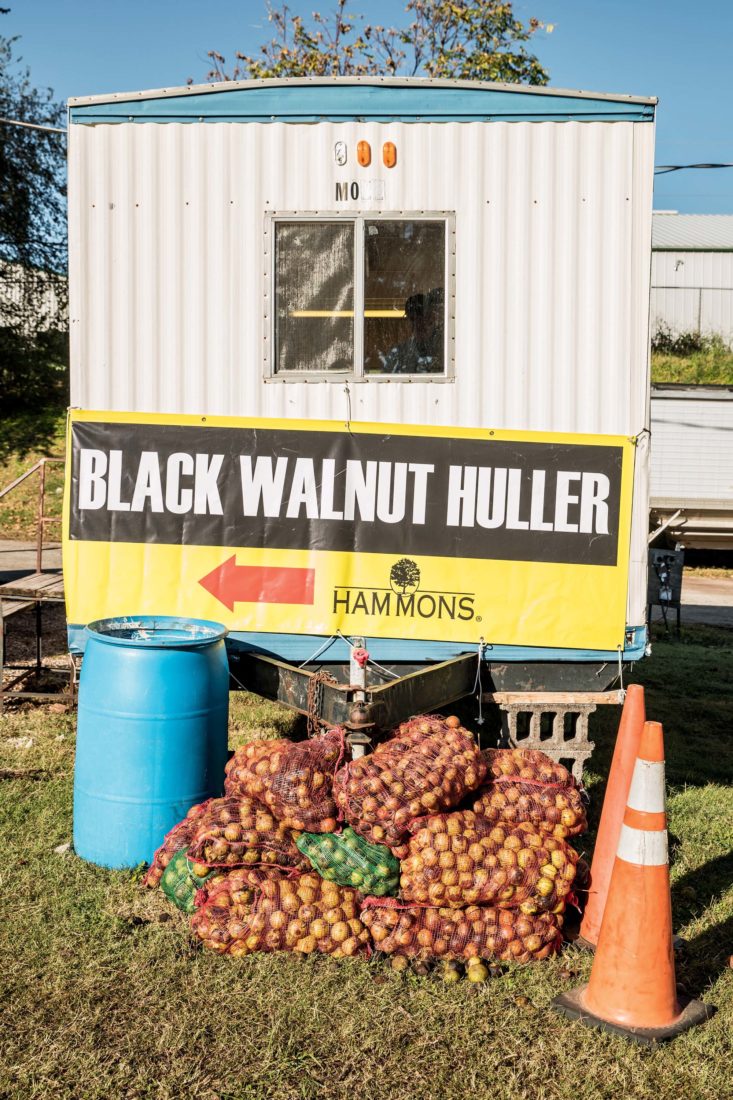
Photo: Eric Kiel
A hulling station sign.
The next day, I arrange to pick with two men that Jim Noble, the hulling station boss here, counts among his best pickers. I’m standing in a parking lot near Battlefield Mall in Springfield when another classic truck—what’s with these guys?—swings slowly into the lot. Seventy yards out, it gives a throaty growl and catapults itself forward fifty yards before stopping. Inside, Wilford Maples and Clyde Gilmore, both in their seventies, grin. “I’m guessing that’s not the engine this thing came with,” I say by way of a greeting. “Nope,” Clyde says. They tell me the truck’s a ’66 Chevy S10 half ton with a hopped-up 327 engine, a V-8 with a four-barrel carb, RV cam, and solid lifters. My experience isn’t wide, but every farm boy I’ve ever met increased his truck’s horsepower at one time or another. Clyde tells me rigs like this are called sleepers. Even the two exhaust pipes vent behind the tires so they can’t be seen from the rear. “People go to pass these two old guys and we goose it. Lady in some kind of Porsche SUV tried it the other day.” He smiles. “Shoulda seen the look on her face.”
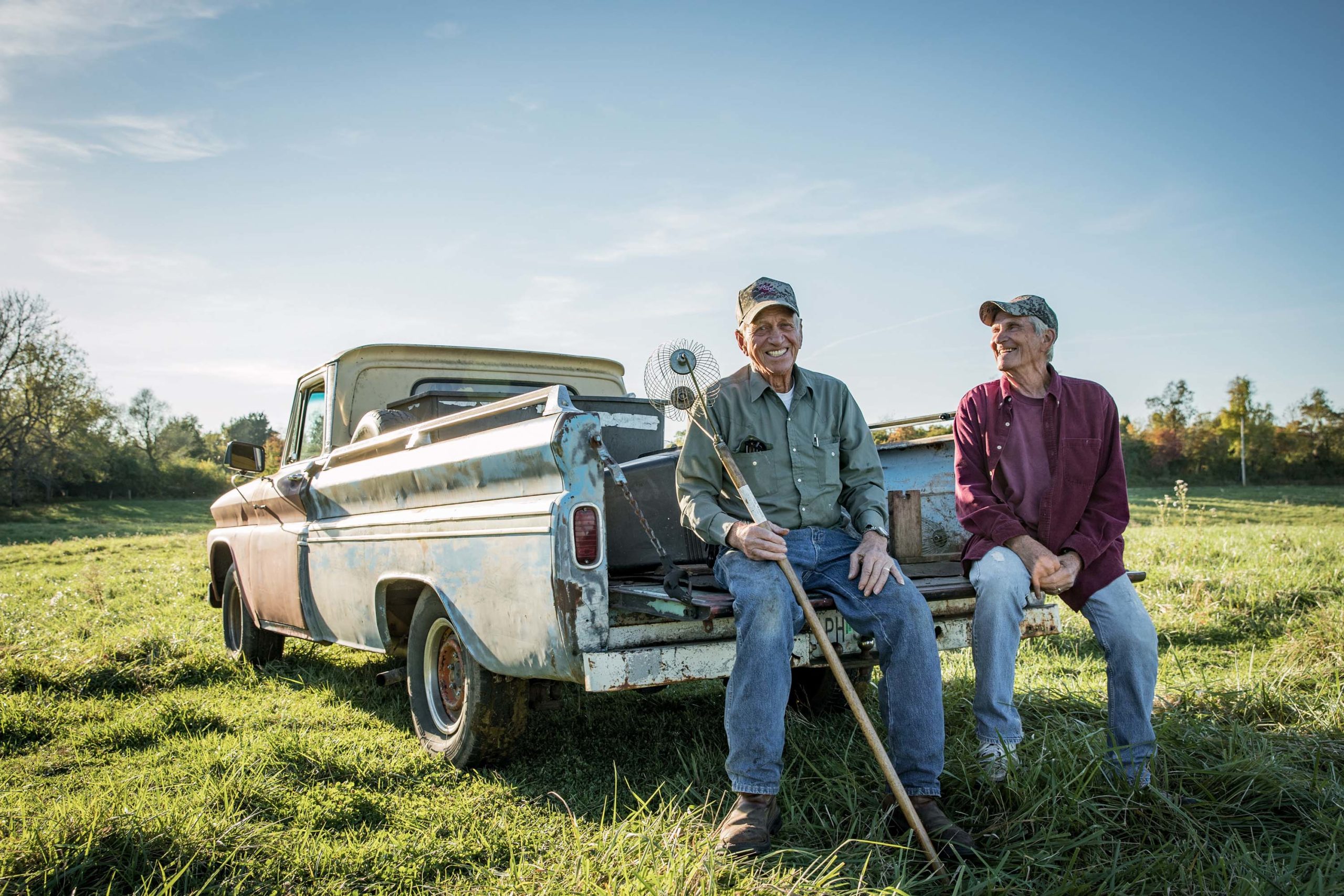
Photo: Eric Kiel
Pickers and cousins Wilford Maples (left) and Clyde Gilmore, with a Nut Wizard.
Wilford and Clyde both grew up on farms, then drove trucks for forty years. “I grew up so far back in the hills they had to pump the sunshine in,” Clyde says. “Hoot owls for watchdogs and wildcats for alarm clocks.” Wilford nods. “Work was all we ever did as kids,” he says, “so for us to sit around and not do anything wouldn’t do.” The two are cousins but as close as brothers. As pickers, they have a secret weapon—exclusive rights to three area golf courses. Keeping these properties requires consistency (you pick rain or shine), thoroughness (you pick up every nut you see), and discretion. “If there’s a tournament or something, we make ourselves scarce,” Wilford says. “If it’s casual golfers, you have to sorta read them. Some are happy to talk to you. Some want to be left alone. We don’t interfere with them, and they don’t interfere with us.”
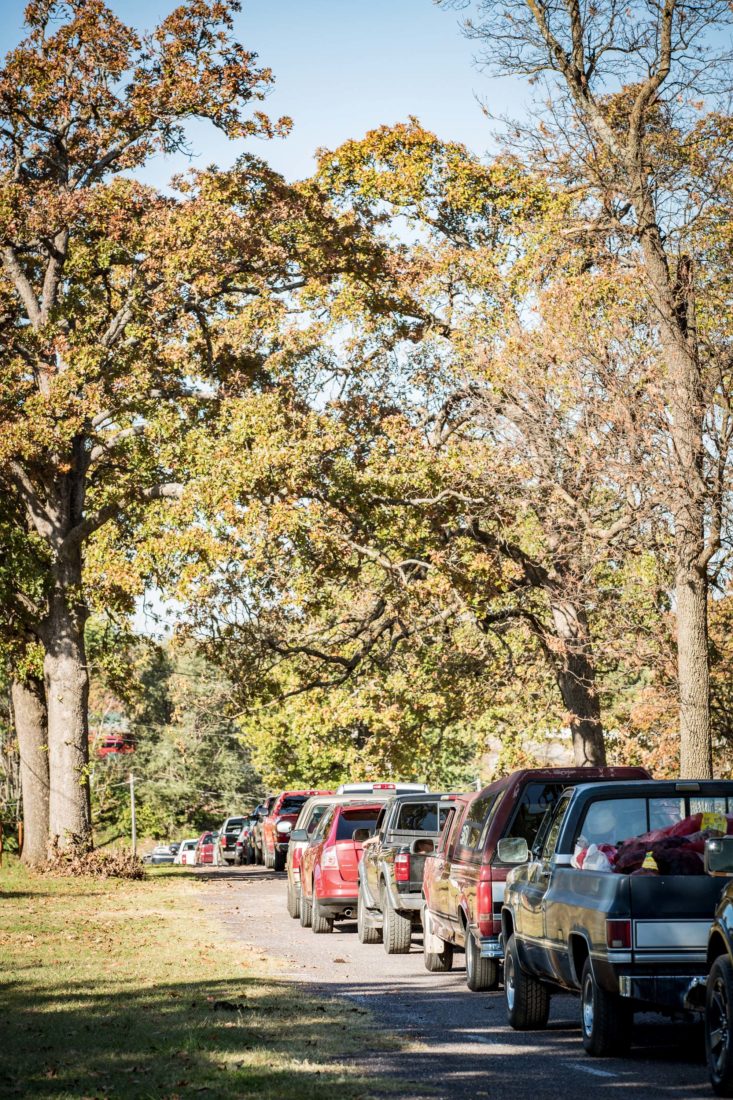
Photo: Eric Kiel
Cars line up to drop off walnuts at a hulling station.
Golf courses aren’t on the menu today. Instead, we drive to a gated community nearby. “A lot of homeowners just want the nuts gone,” Clyde says. “They’ll see the truck and ask if we want to do their yard.” We back into the driveway of a house and soon start rolling our Nut Wizards. The nuts are thick here. You can’t put your foot down without covering at least three, and we fill the Wizards with just a few strokes. Two full Wizards almost fill a five-gallon bucket. I figure I’m most useful as muscle and carry their buckets to the truck. A full bucket weighs about twenty-five pounds. You’re more balanced if you carry two at a time. As I roll and carry, I realize that I’m enjoying myself. It’s football weather, crisp and sunny. The oaks and maples are saturated with fall colors. The work is repetitive but not monotonous. Maybe that’s because the progress is tangible. You see the results in the ever-fuller truck bed, the slowly increasing sag in the suspension.
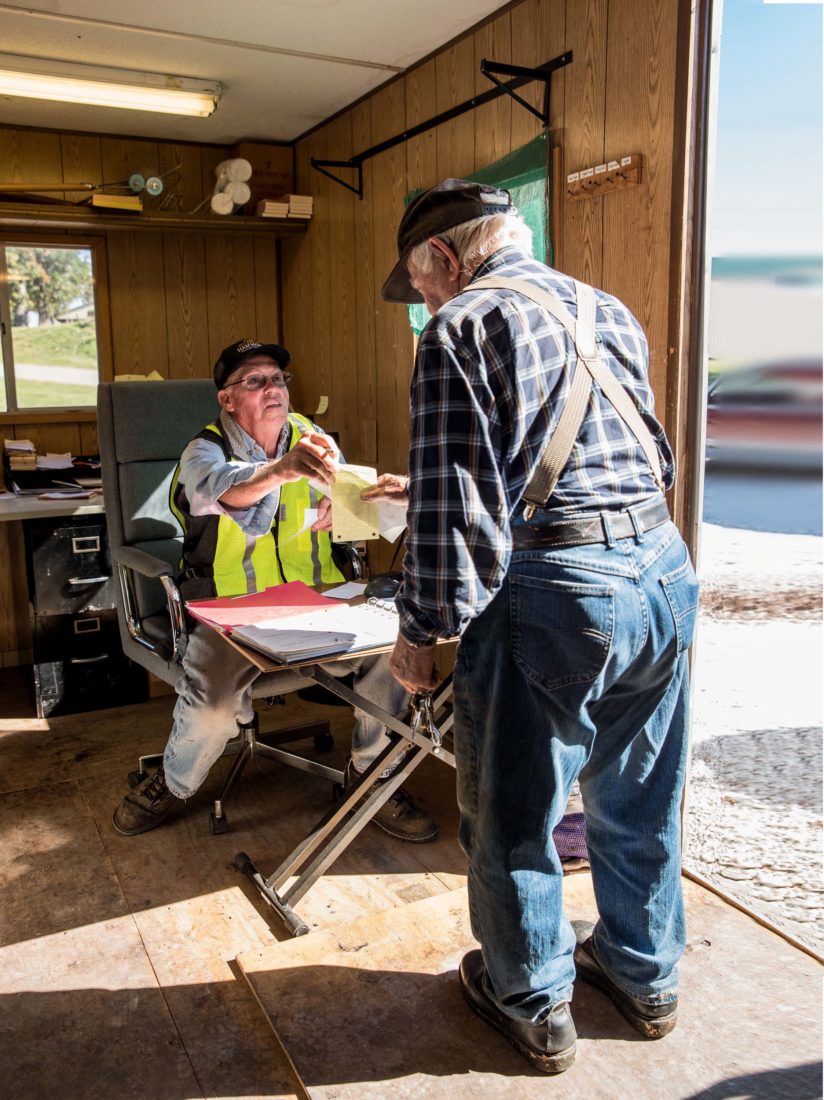
Photo: Eric Kiel
Hulling station boss Jim Noble pays a picker for his haul.
And something in me is getting triggered. The more nuts we get, the more I want. I’m keenly attuned to the fact that it took a year for this moment to arrive, for the nuts to form, grow, ripen, and fall. There’s an insistent nowness to it, to ripeness itself. The nuts are right here right now, but they won’t be here long and won’t be back for another year. A kind of mania overtakes me, a shot of pleasurable neurotransmitters. I know this feeling, have felt it before while collecting ripe wild things—wineberries, pawpaws, asparagus. I’ve even named it—abundance mania. Your consciousness telescopes down. There is only the next nut and the next and the next. You have no choice but to be present in the moment. It’s deep and so easily aroused that I’m convinced it’s a survival mechanism, part of our evolutionary hardwiring. The switch is there inside all of us, but you won’t know it unless, by accident or intention, you reach in and turn it on.
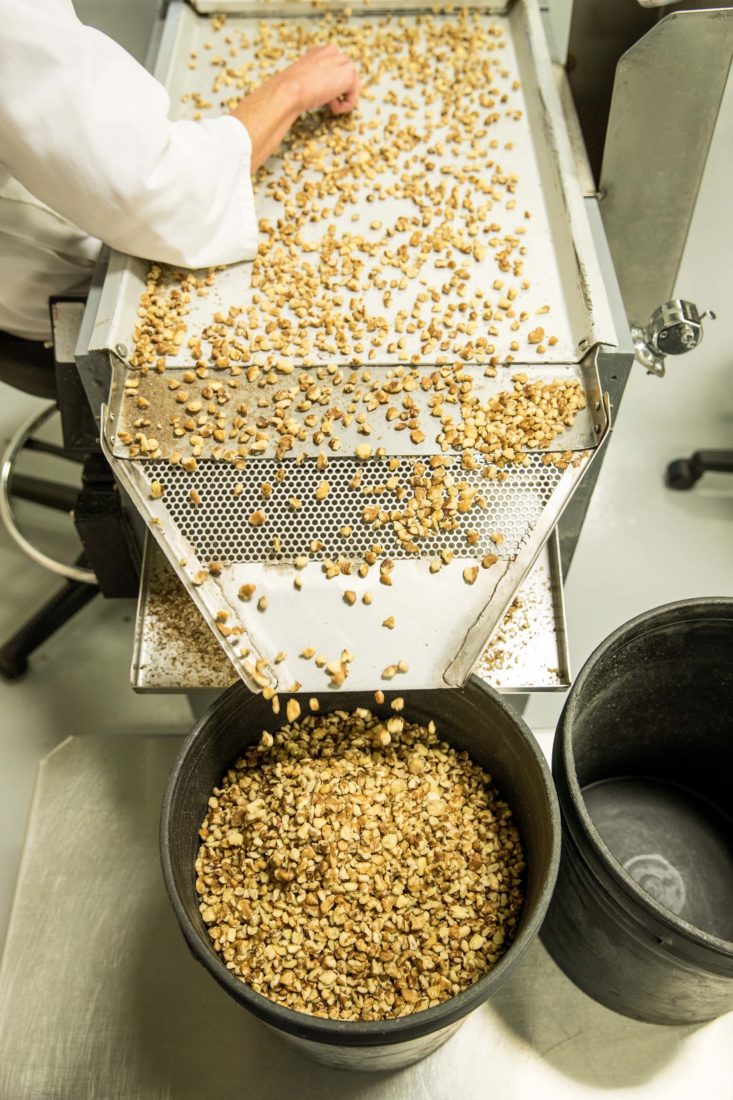
Photo: Eric Kiel
A vibrating inspection table at the factory.
To increase the truck’s capacity, Wilford and Clyde have two fifty-gallon plastic bins in back that rise above the sides. We’ll fill those, then dump into the bed. The two have had a good season so far, six tons, and there’s still another ten days of picking. Clyde is the jokester of the two. At one point, he says, “It’s not the money so much, really. It’s getting to see people’s faces watching these two old men pick up walnuts.” Wilford is at the back fence on his knees, attacking a big pile. “The lawn guys hate ’em,” he says. “Just chucked them back here.” A Wizard won’t work here. You just get down on your knees and hand shovel them into the bucket. I relieve Wilford of two full buckets, and with the bins now full, I dump into the bed. “Hey, Clyde!” Wilford calls across the fence, fifty yards off. “Hear that? He’s dumping into the bed. We already got twenty buckets!”
I work with them until early afternoon, when I leave to meet up with Shaun and Terry Crocker, another pair of Jim Noble’s top producers. I find the couple in a municipal park they’d prefer I not name. Shaun is in his early sixties, in overalls and a blue bandanna with stars on it. Terry, a few years younger, has long brown hair and big peace-sign earrings that sparkle when the sun hits them right. They’ve been married more than thirty years, happily by the looks of things. Both are retired, although not by choice. Shaun worked for the railroad for twenty-eight years, making his way up from trackman to welder to foreman. But after he had neck surgery, the doctor told him not to lift anything over twenty-five pounds. “Hell, your lunch box weighs that much,” he says. The railroad cut him loose two years short of the thirty needed for full retirement. He’s on disability, which pays considerably less. Terry worked as a customer service rep at a local cable company. But then a heart attack laid her up for a few months. She returned to find they had a new computer system that no one was assigned to train her on, nor did anyone have the inclination.
They, too, pick six days a week during October. So many hours that the round baskets of their Wizards deform into football shapes. They buy new ones each season. “Best we ever did was about twenty-four thousand pounds,” Terry says. “That was a good Christmas. They say money doesn’t grow on trees, but I’ve got to disagree.”
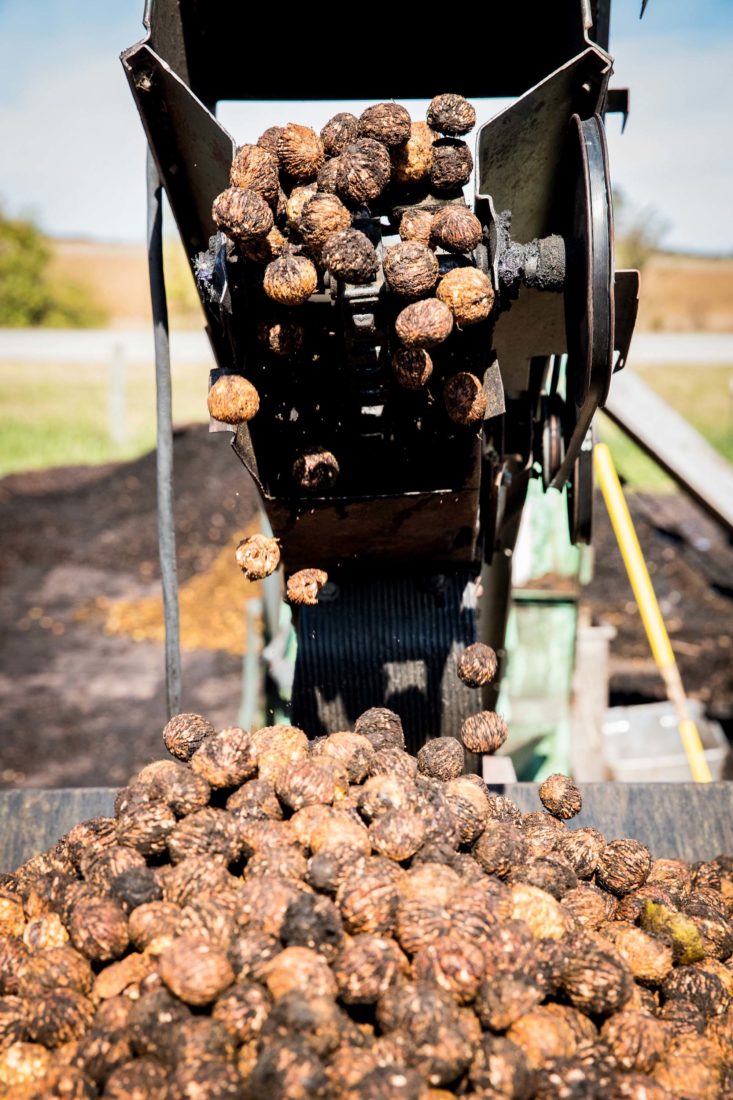
Photo: Eric Kiel
A machine removes the nuts’ green husks.
As we pick, Shaun says he’s seen every kind of car at the hulling station, Mercedes to Volkswagen. Terry remembers a woman who pulled up in a red LeBaron convertible, white interior, just loaded with nuts. “After she unloads, she asks, ‘Can I just wipe down the interior and get it clean?’ And I was like, ‘Are you like this all the time or is today a special occasion?’” Her tone isn’t snarky. She seems rather to be marveling at how different one person can be from another. You can bet the woman in the LeBaron didn’t grow up on a farm.
Shaun and Terry knew each other long before they got together. Their mothers were childhood friends. They connected when both found themselves recently divorced. “Picked me up, didn’t you?” Shaun teases. “Just like a nut.”
“Best nut I ever found,” she answers.
We leave the park and do a couple of houses. One has a large bronze of a stag in the front yard. There are lots of nuts, some of which we have to kick away from stone walls and chain-link fences for the Wizards to get. “This part feels like yard work,” I tell Shaun. He nods. It’s not his favorite, either. “You can’t just take the easy ones, though,” he says. “You have to pick clean if you want people to keep asking you back.” We do this, then move to a house where we have to coil the hose and kick nuts out of the ivy. Shaun says he has noticed that trees along roads drop earlier than other trees. He thinks it could be the vibration from passing traffic.
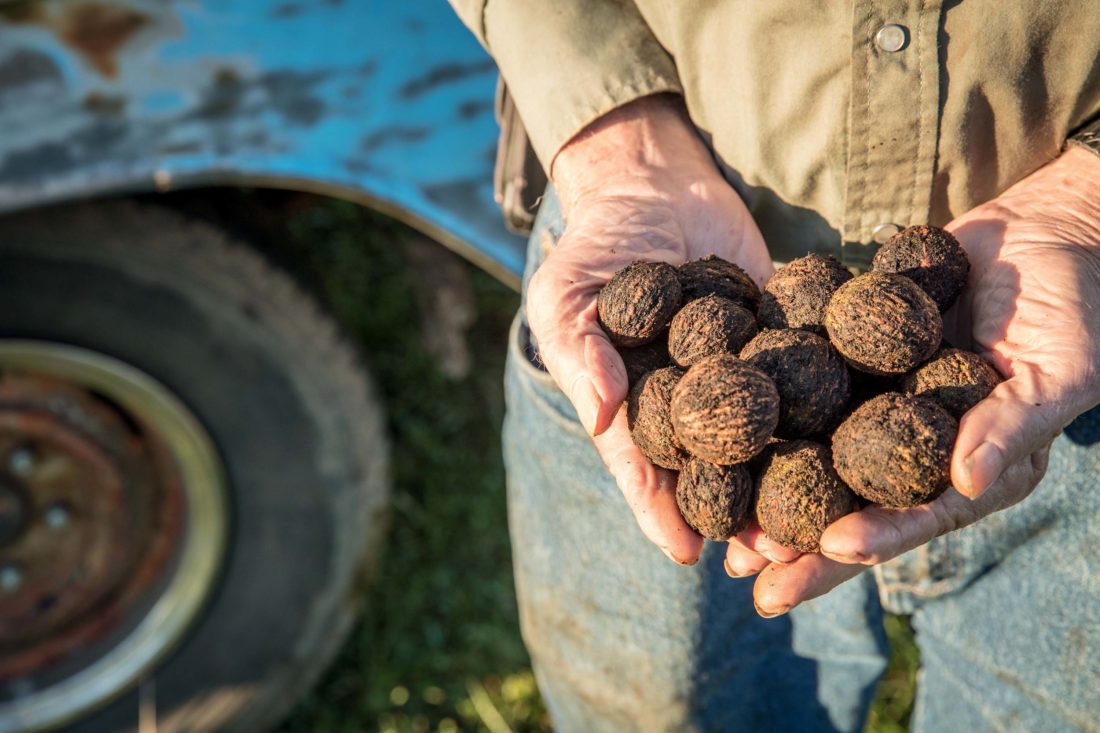
Photo: Eric Kiel
Freshly hulled black walnuts in the shell.
As the light starts to go and we’re hauling our last buckets to the truck, I ask Terry about her heart attack. “I died in the ambulance,” she says. “My heart stopped. All I remember is the nurse saying, ‘She’s coding.’ Next thing I knew I was in heaven. I saw my mom, dad, my brother Ray, my uncle Bill. And behind them all these silhouettes of people as far as I could see. I didn’t recognize them, but I knew they were my family. Because I just felt so much love. It was so peaceful. So don’t worry about dying, honey. It’s the easiest thing you’ll ever do.” She pauses. I ask her to continue. “Well, next thing I knew I was looking down at my body in the ambulance. And I knew I was going back to it and that it was going to hurt. A heart attack hurts really bad, you know. After that, I woke up in a hospital and knew I was going to be all right. Anyway, don’t worry about dying, honey. Death was easier than anything I’ve done in my life. Till I hooked up with this ole boy.” She smiles at Shaun. He studies his boots, almost blushing. “It’s peaches and cream now.”
We go back to the park and pick until the light is almost gone. We’ve dumped our last full buckets when Terry squints into the light cast by one of the park lamps, which have just come on. She’s looking at the ground beneath a tree. We picked it clean three hours ago and already there are hundreds of new ones. Big ones, close together. “Be right back, hon,” she says to Shaun, grabbing a bucket. “I just can’t stand to leave those nuts lying there.”



